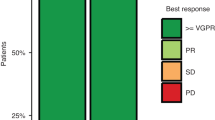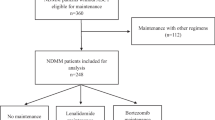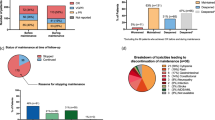Abstract
Achieving a first complete remission in myeloma has become feasible with novel agent-based combination therapies followed by autologous stem cell transplantation (ASCT), leading to CR rates of 40%. But continuously occurring relapses in these patients have lead to the revival of maintenance (MT) concepts aiming to eliminate or control minimal residual disease when myeloma burden is low and not too many clonal tidings have been induced. On the other side, the clinical effectiveness of MT has to be balanced against its considerable cost, toxicity and effects on quality of life. Owing to low effectiveness and side effects of chemotherapy, steroids as monotherapy and α-interferon are obsolete options for maintenance concepts, while low-dose thalidomide should be considered in low-risk patients that do not achieve at least very good partial remission after ASCT, when other MT options are not available. There is limited data on the effectiveness of Bortezomib (BTZ) MT in high-risk patients with respect to both progression-free survival (PFS) and overall survival (OS). Lenalidomide (LEN) MT after ASCT shows a clear PFS benefit, but data on OS and the influence on the outcome of subsequent therapies are conflicting. Toxicity includes haematotoxicity, venous thromboembolism and the induction of secondary primary malignancies. LEN-MT cannot be considered a standard approach after ASCT yet, but should be discussed on a case by case basis with every patient, as well as BTZ-MT in t(4;14) positive myelomas. In non-transplant eligible patients keeping patients on prolonged therapies has been shown to be beneficial and the distinction to MT is often purely semantic.

Similar content being viewed by others
References
Kumar SK, Dispenzieri A, et al. Continued improvement in survival in multiple myeloma: changes in early mortality and outcomes in older patients. Leukemia. 2014;28(5):1122–8. doi:10.1038/leu.2013.313..
Rajkumar SV, Gahrton G, Bergsagel PL. Approach to the treatment of multiple myeloma: a clash of philosophies. Blood. 2011;118:3208–11. doi:10.1182/blood-2011-06-297853.
Cavo M, Pantani L, et al. Bortezomib-thalidomide-dexamethasone is superior to thalidomide-dexamethasone as consolidation therapy after autologous hematopoietic stem cell transplantation in patients with newly diagnosed multiple myeloma. Blood. 2012;120:9–19.
Belch A, Shelley W, et al. A randomized trial of maintenance versus no maintenance melphalan and prednisone in responding multiple myeloma patients. Br J Cancer. 1988;57:94–9.
Fritz E, Ludwig, H. Interferon-alpha treatment in multiple myeloma: meta-analysis of 30 randomised trials among 3948 patients. Ann Oncol. 2000:11:1427–36.
Shustik C, Belch A, et al. A randomised comparison of melphalan with prednisone or dexamethasone as induction therapy and dexamethasone or observation as maintenance therapy in multiple myeloma: NCIC CTG MY.7. Br J Haematol. 2007;136:203–11.
Hicks LK, Haynes AE, et al. A meta-analysis and systematic review of thalidomide for patients with previously untreated multiple myeloma. Cancer Treat Revi. 2008;34:442–52.
Singh PP, Kumar SK, et al. Lenalidomide maintenance therapy in multiple myeloma: a meta-analysis of randomized trials. Blood. 2013: ASH abstract 407. https://ash.confex.com/ash/2013/webprogram/Paper62973.html.
Palumbo A, et al. Second primary malignancies with lenalidomide therapy for newly diagnosed myeloma: a meta-analysis of individual patient data. Lancet Oncol. 2014;15:333–42.
Palumbo A, et al. Autologous transplantation and maintenance therapy in multiple myeloma. N Eng J Med. 2014;371:895–905.
Ludwig H, Sonneveld P, et al. European perspective on multiple myeloma treatment strategies in 2014. Oncologist. 2014;19:829–44.
Sonneveld P, Schmidt Wolf IGH, et al. Bortezomib induction and maintenance treatment in patients with newly diagnosed multiple myeloma: results of the randomized phase III HOVON-65/GMMG-HD4 trial. J Clin Oncol. 2012;30:2946–55. doi:10.1200/JCO.2011.39.6820.
Palumbo A, Bringhen S, Larocca A, et al. Bortezomib-melphalan-prednisone thalidomide followed by maintenance with bortezomib-thalidomide compared with bortezomib melphalan-prednisone for initial treatment of multiple myeloma: updated follow-up and improved survival. J Clin Oncol. 2014;32:634–40.
Author information
Authors and Affiliations
Corresponding author
Rights and permissions
About this article
Cite this article
Willenbacher, W., Willenbacher, E. To maintain or not to maintain: treatment forever in myeloma?. memo 8, 26–29 (2015). https://doi.org/10.1007/s12254-014-0185-1
Received:
Accepted:
Published:
Issue Date:
DOI: https://doi.org/10.1007/s12254-014-0185-1




